Shelf Life
Paradiso Lost
by Erin Finnegan,

None this week
Rental Shelf
None this week
Perishable
None this week
Stream Worthy
Ristorante Paradiso ep 1-11 (complete)
Durarara!! Episodes 1-7
The Diary of Tortov Roddle, episodes 1-7
Flushable
It just so happened that Tokyo Anime Fair was going on around the same time. I saw a lot of ads for Ristorante Paradiso there. After TAF I hung out with Ed Chavez (of the Manga Cast and later Vertical, Inc.) and Felipe Smith (creator of MBQ and Peepo Choo) as they complained about manga-ka Natsume Ono's seinen titles. They just don't like her storytelling style.
Nevertheless, I was excited to read Ono's manga. I happened to review Ono's Not Simple a few months ago, and I was frustrated with the story but delighted by the art. I liked Ristorante Paradiso (the anime) much, much more than Not Simple.
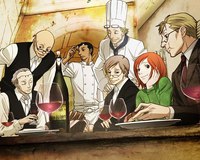 Let it never be said that I don't like slice-of-life anime. It's hard to get excited about a watching a relaxing show like Aria (which I never finished). But the older I get, the more stressed out I feel, so I'm glad Ristorante Paradiso was simulcast! It has the same sedative effect on me as a glass of wine (the characters in the show also drink a lot of wine). Unfortunately, it caused my husband to roll his eyes copiously and mock the show mercilessly.
Let it never be said that I don't like slice-of-life anime. It's hard to get excited about a watching a relaxing show like Aria (which I never finished). But the older I get, the more stressed out I feel, so I'm glad Ristorante Paradiso was simulcast! It has the same sedative effect on me as a glass of wine (the characters in the show also drink a lot of wine). Unfortunately, it caused my husband to roll his eyes copiously and mock the show mercilessly. Twenty-one-year-old Nicoletta moves to Rome to confront her mother, Olga, who left her to be raised by her grandparents when she remarried to an Italian restauranteur with a strict "no kids" dating policy. Nicoletta became her mother's secret child, and turns up in Rome under the guise of being her mother's friend's daughter.
Olga manages her husband's restaurant, the Casetta dell'Orso, which is staffed exclusively by older men who wear glasses (she has something of a fetish). Nicoletta lands a job working in the kitchen. The series meanders for the next nine episodes as Nicoletta learns about the gentlemen on staff.
Ristorante Paradiso has some structural problems that would get you in trouble at NYU Film School. First, Nicoletta is a passive protagonist after the first episode. She stops trying to confront her mother, and after one failed tryst, she's in no hurry to get romantically involved with any of the waiters. Nicoletta stops moving the plot forward.
Second, a lot of the action takes place in the past. Several episodes play off a wall of staff photographs in the restaurant. One character will recall a story about another character in the photo. Therefore, a lot of the action unfolds in flashbacks. I hate over-reliance on flashbacks (like in some of the Harry Potter books). It's not strong narrative structure.
In several episodes, something almost happens, with each ending maintaining the status quo. It's hardly gripping television. A conflict transpired in the past; someone almost said something about it in the present but didn't; Nicoletta almost learns something about the nature of love; the end.
Fortunately the series is short, and it redeems its flaws in the satisfying final episode when (gasp) something actually happens.
Speaking artistically, Ristorante Paradiso looks similar to Antique Bakery. I love Fumi Yoshinaga, but I've only watched a few episodes of the Antique Bakery anime. It's all pastel colors and cute men. Not cute guys, but cute men. Honestly, the guys in Ristorante Paradiso are a tad old for my tastes.
I love Ono's character designs… but I did have a hard time telling some of the waiters apart. There is even a female character who looks nearly identical to Nicoletta.
The background paintings and occasional CG camera moves through the streets of Rome really give a feel for the city. I've never been to Rome, but thanks to this series and the 1953 film Roman Holiday, I feel like I have. It seems like a relaxing city! [TOP]
Fortunately, the food at Casetta dell'Orso looked delicious without leaving me craving Italian cuisine. Speaking of delicious resturaunts, on my aforementioned trip to Tokyo I had a humongous Zodiac-themed parfait at Milky Way Café in Ikebukuro.
I was in Ikebukuro exploring Otome Road. It's where the fujoshi and female otaku shop. I ate at 80+1, a butler café staffed by girls dressed like guys (Takarazuka style!). It was great. I loved Ikebukuro, so I'm probably biased towards Durarara, which is set entirely in the neighborhood.
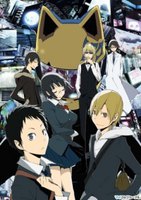 Durarara!! is based on a series of light novels by Ryohgo Narita, the author of Baccano!. As you might remember, I loved Baccano!. Durarara!! strikes me as Narita's earlier work, but it started one year after Baccano!. Both novel series are ongoing, which seems odd, since the ending of Baccano! felt very final.
Durarara!! is based on a series of light novels by Ryohgo Narita, the author of Baccano!. As you might remember, I loved Baccano!. Durarara!! strikes me as Narita's earlier work, but it started one year after Baccano!. Both novel series are ongoing, which seems odd, since the ending of Baccano! felt very final. Both anime series open with a long pan over a large ensemble cast, complete with freeze frames. Both have gang/mob violence with super natural elements at work and highly appealing soundtracks. Baccano! was Depression Era fun but Durarara!! is "Present day! Present time!" as they say in Serial Experiments Lain. (Studio Sokodei once parodied that with "Arbor Day! Miller Time!" and I still think it's hilarious.)
Durarara!! opens with Mikado's commute in from the suburbs to check out his new high school in Tokyo, specifically in Ikebukuro. He's familiar with the neighborhood primarily through Ikebukuro West Gate Park, a real-life manga (published by DMP in the U.S.) and drama series. Mikado meets his elementary school buddy Masaomi, a fast-talking legend-in-his-own-mind who introduces Mikado to the neighborhood characters.
And there are a lot of characters. A huge "black Russian" who hocks Russian sushi on the street, a 23-year-old scientist who studies the local legendary headless motorcyclist, a suicidal schoolgirl who gets kidnapped, a mysterious information broker, some local manga fans and their foreign ticket scalping friend are all introduced over the first six episodes. Episode seven introduces Shizuo, sure to be everyone's favorite character, because he throws around vending machines when he gets angry.
Durarara!! serves up a lot to love. I find the show reminiscent of Satoshi Kon's Paranoia Agent, one of my favorite series of all time. Paranoia Agent was much darker and creepier, but like Durarara!!, each episode is a little vignette about one of the characters and his role in a large interconnected story.
Durarara!! has a considerably lower budget than Paranoia Agent. I'm assuming producers just throw money at Satoshi Kon's feet, like flower girls throw petals before a bride. A solid chunk of time in each episode of Durarara!! is devoted to scrolling over an internet chat log as characters trade neighborhood rumors. It's not badly done, but as someone who has worked in animation, I can hear a cash register sound in my brain every time the show cuts to the chat room. God, they're saving so much money!
The character designs are by Suzuhito Yasuda, the manga-ka of Yozakura Quartet (published by Del Rey). Yasuda is primarily an illustrator, and Yozakura Quartet is his first manga. I love his illustrations but have no confidence in his storytelling ability. The anime adaptation of Yozakura Quartet is better than the manga, because it corrects the manga's structural problems. One girl in Durarara!! (the one with scars on her neck) looks ominously like Rin in Yozakura Quartet.
Because Durarara!! is currently being simulcast on Crunchyroll and only up to episode seven at the moment, it's hard to draw long term conclusions. So far, I like it a lot. It may be the case that I am willing to tolerate any of the show's shortcomings because I love Ikebukuro and Baccano!. I just hope the characters eat giant parfaits at the Milky Way Café eventually.[TOP]
Ikebukuro is a little weird in real life, and weirder in Durarara!!, but it's not as weird as Tortov Roddle's world.
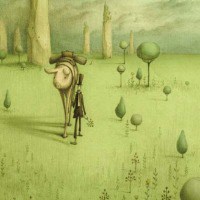 The Diary of Tortov Roddle is a series of animated shorts by Kunio Kato, who won the Oscar for Best Animated Short for his 2009 film La Maison en Petits Cubes. The Tortov Roddle shorts are listed in our database as a newfangled ONA, "Original Net Animation". Most of the shorts are available on crunchyroll, but episodes eight and nine are only available as DVD extras.
The Diary of Tortov Roddle is a series of animated shorts by Kunio Kato, who won the Oscar for Best Animated Short for his 2009 film La Maison en Petits Cubes. The Tortov Roddle shorts are listed in our database as a newfangled ONA, "Original Net Animation". Most of the shorts are available on crunchyroll, but episodes eight and nine are only available as DVD extras. As an anime fan, it's easy to overlook Japan's non-commercial animation. It's not like these arty animated shorts are tied to manga, or airing on television, or screaming to be seen by our demographic.
Tortov Roddle was obviously made to play to an international audience of animation festival judges. Like Petits Cubes, this is the kind of thing designed to win awards. If you like it (all of the shorts add up to less than half an hour) you should check out Mt. Head, these shorts from the Yokohama Arts Foundation, Ghiblies (if you can find it), The Animation Show compilations, and Spike and Mike's Classic film channel.
In The Diary of Tortov Roddle, our protagonist, Tortov, travels through a surreal landscape on a pig with long legs, like Salvador Dali's elephants. Actually the setting looks pleasantly similar to Salvador Dali's paintings. Roddle's small adventures unfold with the logic of dreams. I think Roddle's "Diary" is more like a dream journal.
There isn't a lot of dialog in each film (note to future filmmakers: If you want sweep international film festival awards, don't use much dialog). In fact, the Tortov shorts have all the hallmarks of really successful animated shorts: only a handful of characters, moments of discovery, and a single twist. When you only have three minutes to make an impression, it's important to keep things simple.
Without reading the credits, it's hard to tell Tortov was made in Japan. The character wears a tall stovepipe hat, everyone has tiny, tiny eyes, and a city in one of the shorts looks European, in a surreal way. One of the things I like about anime is its distinctive Japanese quality. Tortov was not distinctly Japanese, but it appealed to me as a fan of international animation.
These shorts are definitely worth watching. Kato does a great job of bringing dreams to life on screen. Tortov is an interesting character; we never find out why he he's on a Kino's Journey sort of journey, but it's still satisfying to watch without knowing the backstory. The painterly animation is reason enough to watch this, but you definitely don't want to miss the freaky (yet friendly) giraffe-pig. [TOP]
Due to some unavoidable circumstances, this week's column was exclusively about streaming series.
I find it much easier to give streaming titles high ratings since they don't cost anything and don't take up space on my shelves (or my hard drive). That said, a show that's Stream Worthy now might not be Shelf Worthy later if and when a DVD comes out.
Next week I'll also take a look at some more streaming shows.

This week's shelves are from Logan:
"These are my shelves including everything from Christmas. I know its small but I'm proud of it. This isn't even 1/4 of the total anime/manga/figure/accesorries that I have on my 'to buy' list, but unless I get something better than $9.25 an hour at 16 years old (Just turned 16), I'll be getting more slowly but surely. :D"
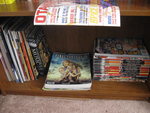
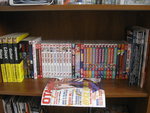
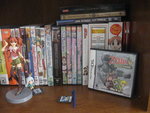
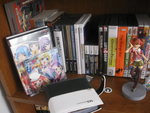

Not bad!
Want to show off your stuff? Send your jpgs to shelflife at animenewsnetwork dot com. Thanks!
discuss this in the forum (68 posts) |